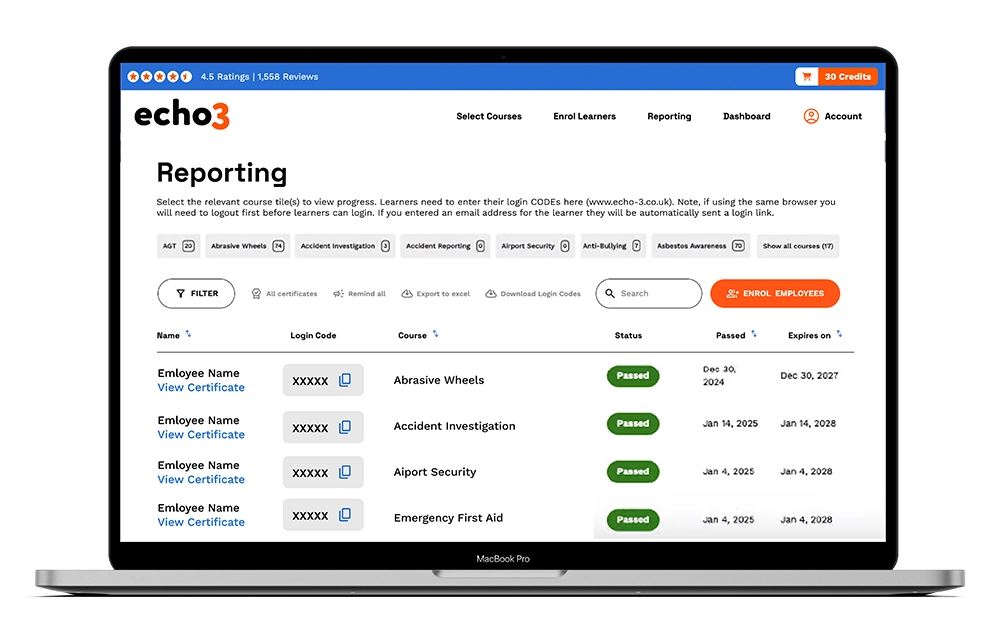DSE AWARENESS
 DSE Awareness online course accredited by the Chartered Institute of Ergonomics and Human Factors (CIEHF).
DSE Awareness online course accredited by the Chartered Institute of Ergonomics and Human Factors (CIEHF).
Using Display Screen Equipment (DSE) such as PCs, laptops, tablets and smartphones has become part and parcel of modern life. However, health risks linked to DSE use at work continue to account for over 80% of all work-related ill-health.
So Employers have legal duties under the Health and Safety (Display Screen Equipment) Regulations 1992 to appropriately manage the risks associated with DSE use in the workplace, and to provide information and training on safe use.
The Echo3 accredited online DSE Awareness training course helps employers meet legal training requirements and provides staff with the knowledge needed to reduce their risk from DSE use. The course provides clear information on the safe use of technology both in and out of the office.
This DSE Awareness course is also available with a version that includes a DSE self-assessment.
 Introduction
Introduction- Risks to health
- DSE use at work
- Office ergonomics & posture
- Chair and workstation set-up
- Portable DSE
- Work arrangements
- Hotdesking
- Home working
- Eye and eyesight testing
- The working environment
- Quiz
DSE Awareness Certificate
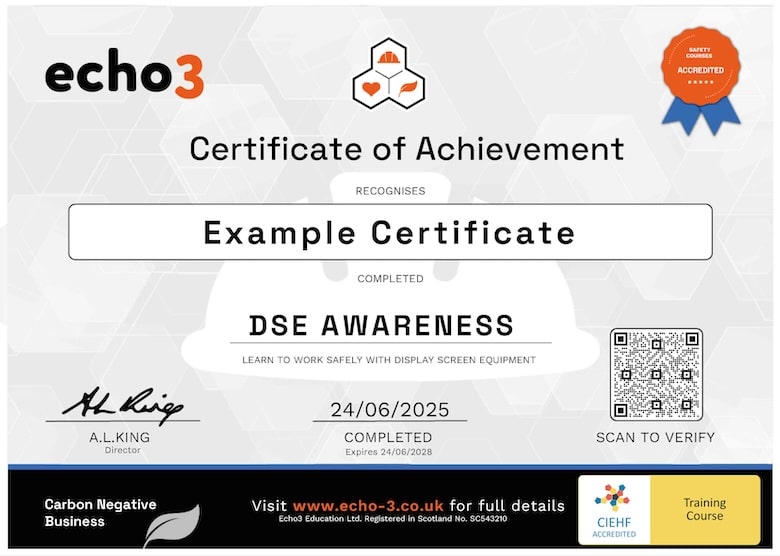
Download and Print Your Certificate
- Written in compliance with the XXX Regulations
- Developed by DSE Scotland & Accredited by CIEHF – learn more about CIEHF here
- Last Updated June 2024
- To gain the certificate you must complete the assessment which involves 10 questions.
- You can access our LMS any time to reprint certificates, check and set pass marks and act as proof of a commitment to ongoing legal compliance.
- The online DSE Awareness certificate is valid for 3 years.
How to use the Echo3 Platform
Individual Learners

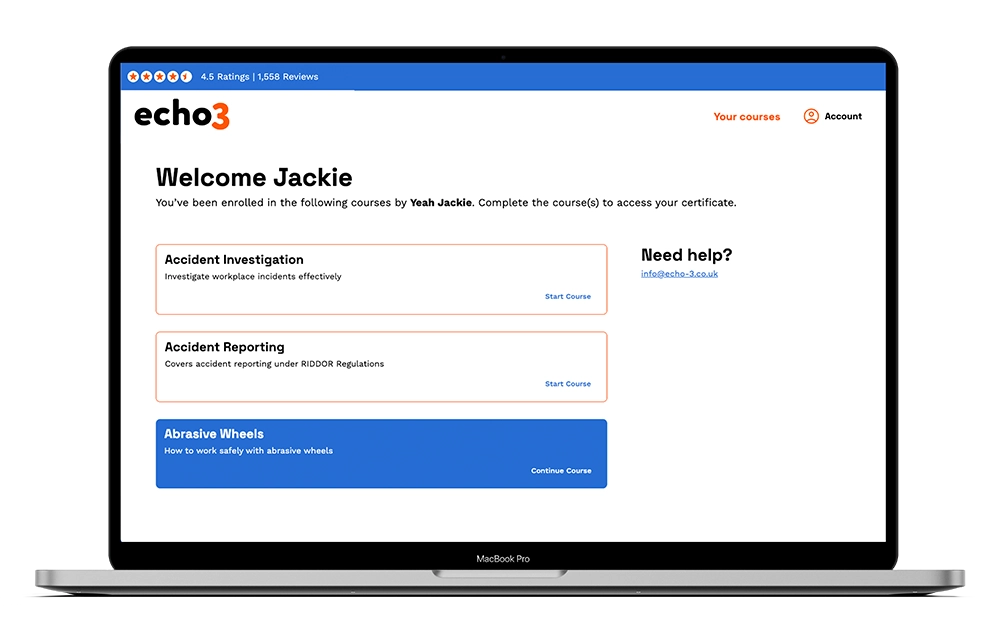
Benefits for Individuals
-
Engaging video-based content
-
Learner dashboard included
-
Instant access after payment
-
Free course retakes
-
Shareable digital certificate
 QR Code Certificate
QR Code Certificate



Bulk Buying Discounts
10 Courses
50 Courses
100+ Courses
Course Preview
Echo3 courses include engaging motion-graphic video content, with full english subtitles
What are the DSE course learning objectives?
 The Learning Objectives from the Echo3 DSE Awareness course online include.
The Learning Objectives from the Echo3 DSE Awareness course online include.
- Understand ergonomic principles for setting up an optimal workstation.
- Identify potential risks and hazards associated with prolonged DSE use.
- Recognise signs and symptoms of discomfort and strain related to DSE use.
- Learn techniques and exercises to prevent common injuries such as eye strain and musculoskeletal disorders.
- Understand the importance of regular breaks and proper posture during DSE use.
- Familiarisation with the UK Display Screen Equipment regulations governing DSE use in the workplace.
- Understand the role of self-assessments to help support safe DSE use in the workplace.
- Learn the optimal ergonomic and environment setups to minimise physical stress and maximise comfort.
Who is this DSE training for?
 The Echo3 DSE course is suitable for all DSE Users.
The Echo3 DSE course is suitable for all DSE Users.
Primarily, this means office workers who spend significant portions of their day using computers or other display screen equipment (DSE). should take this course to learn about ergonomic setup and minimise health risks associated with prolonged usage.
Employees transitioning to remote work setups or those experiencing discomfort or strain from DSE will also benefit.
Supervisors, managers, and human resources professionals should also undergo this training to ensure workplace compliance with health and safety regulations and to promote employee well-being.
What is the legislation related to DSE use at work?
Several pieces of legislation are relevant. The Health and Safety (Display Screen Equipment) Regulations 1992 (as amended) impose specific duties on employers in relation to the use of DSE at work.
Employers must also comply with general legal duties from other pieces of law, including the Health and Safety at Work etc Act 1974, the Management of Health and Safety at Work Regulations 1999, the Workplace (Health, Safety and Welfare) Regulations 1992 (as amended) and the Provision and Use of Work Equipment Regulations 1998 (as amended).
What is a ‘DSE’ user?
Employers must provide appropriate training to all DSE users. In the UK a DSE user is defined as ‘Someone who uses display screen equipment each workday for an hour (or more) at a time’.
If this definition holds true, duties of the DSE regulations apply. Even when employees are mobile workers and/or work from home.
What are employee responsibilities for DSE use?
Under the DSE Regulations, employers must:
- Carry out a suitable and sufficient risk assessment of each workstation. While staff can carry out their own self-assessment, they must first have received the necessary training before being asked to complete one. For complex assessments, trained in-house DSE assessors or external help may be required.
- Ensure workstations meet minimum standards.
- Provide DSE users with appropriate training and information, including on risks to health and available control measures.
- In most cases, record assessment findings and action taken.
- Plan work activities so that DSE use is interrupted.
- Provide eye tests for DSE users on request and provide basic glasses for DSE use if required.
What are the health risk from DSE?
There are three main health risks commonly associated with DSE use.
Musculoskeletal disorders (or MSDs) refer to injury, damage or disorder of the joints or other tissues in the body – think of them as ‘aches, pains and strains’. Common examples include back and neck pain, but MSDs can occur anywhere in the body. Work-related upper limb disorders is a sub-category of MSDs and includes various repetitive strain injury conditions.
Work-related stress, depression or anxiety causes more cases of work-related ill-health than anything else, and most working days lost overall. Pressure of work is the biggest cause of work-related stress.
Taken together, MSDs and work-related stress account for roughly 80% of all work-related ill-health.
Using DSE is a visually demanding thing to do. While far less likely to lead to time off work, visual fatigue involves a range of symptoms including blurred vision, headaches and sore, dry or tired eyes.
What was the assessor course feedback?
”
I just wanted to let you know that I assessed the course by doing it, and it is probably the best DSE assessment course I’ve done. I particularly liked the way the course was structured around the assessment form – this ensures engagement, but also means the learner has achieved the learning outcomes when they’ve finished watching the videos. The content was comprehensive and the linking to the underpinning theory makes it more likely that learners will appreciate how these principles apply to interactions with other environments. I was certainly thinking about ‘the next posture’ all the way home in the car!”
CIEHF ASSESSOR 1.










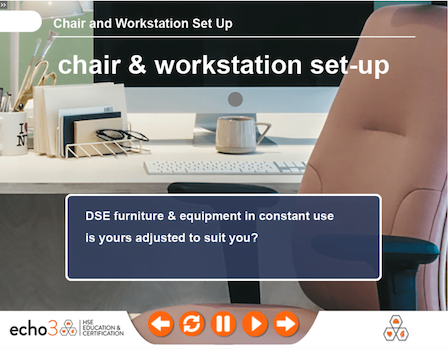

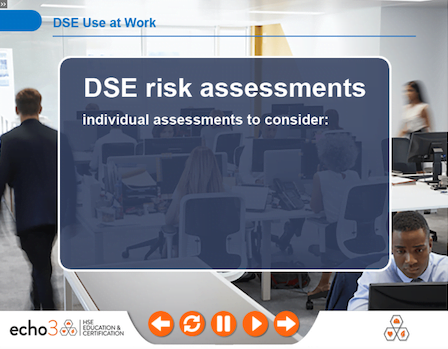
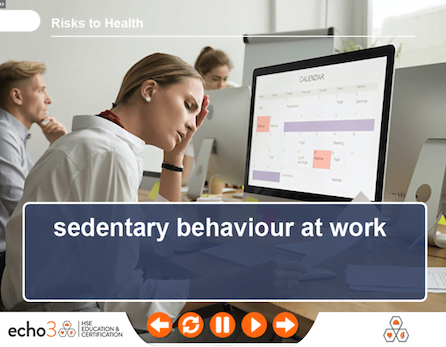
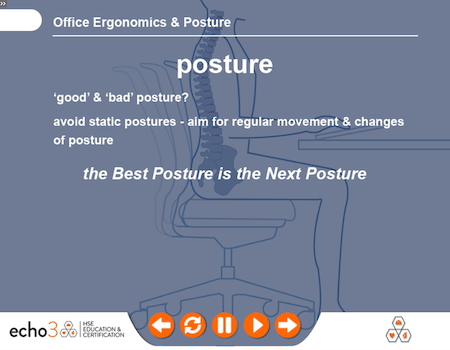
 Introduction
Introduction
